Many people in the US are most familiar with the purple passionflower, with its purple petals and corona, topped with yellow anthers and stamens.
In Europe, growers love the similar-looking bluecrown passionflower, and it’s the most popular variety there.
But few gardeners are closely acquainted with the red banana passionfruit, with its long fuchsia-red petals and insignificant corona.
Or what about Jamaican honeysuckle, featuring relatively petite petals and massive purple and white striped filaments that droop to embrace the stigma and anthers?
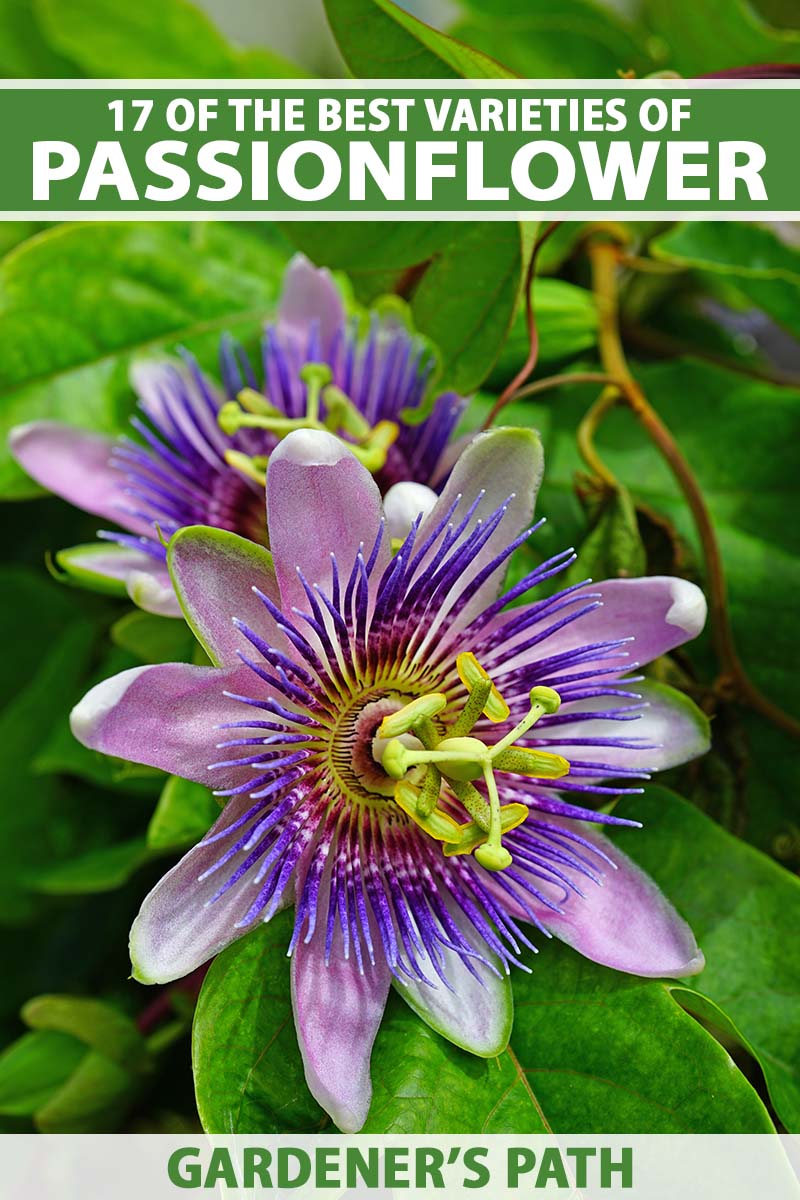
We link to vendors to help you find relevant products. If you buy from one of our links, we may earn a commission.
Passionflowers come in a surprising range of colors, sizes, and shapes. There are nearly 600 known species in the Passiflora genus and over 700 recorded cultivars, most of which are hybrids. Most are vines, but some even have a tree-like growth habit.
The ripe fruit of most cultivated species is technically edible but most of them have a bitter, unpalatable flavor.
Unripe fruits and foliage contain toxic cyanic glycosides and should not be consumed. Unless otherwise noted, species and cultivars listed below should be grown for their ornamental value, not for eating.
If you’re interested in learning about some of the most common and worthwhile species and hybrids to grow at home, keep reading. Here’s what we’ll cover, coming right up:
17 of the Best Passionflower Varieties
A lot of people think they can’t grow passionflowers in their area because the temperatures are too cold in the winter, but there are a few plants that can handle cold temperatures all the way down to 0°F.
Whether you need something cold-hardy or a vine to wow the neighbors – or both! – this guide can help you find it, so let’s climb right in.
1. Blue
P. caerulea is native to South America, and it’s the national flower of Paraguay.
It has been crossed with other varieties to create many beloved hybrids. The flower petals are cream-colored with blue, white, and burgundy filaments.
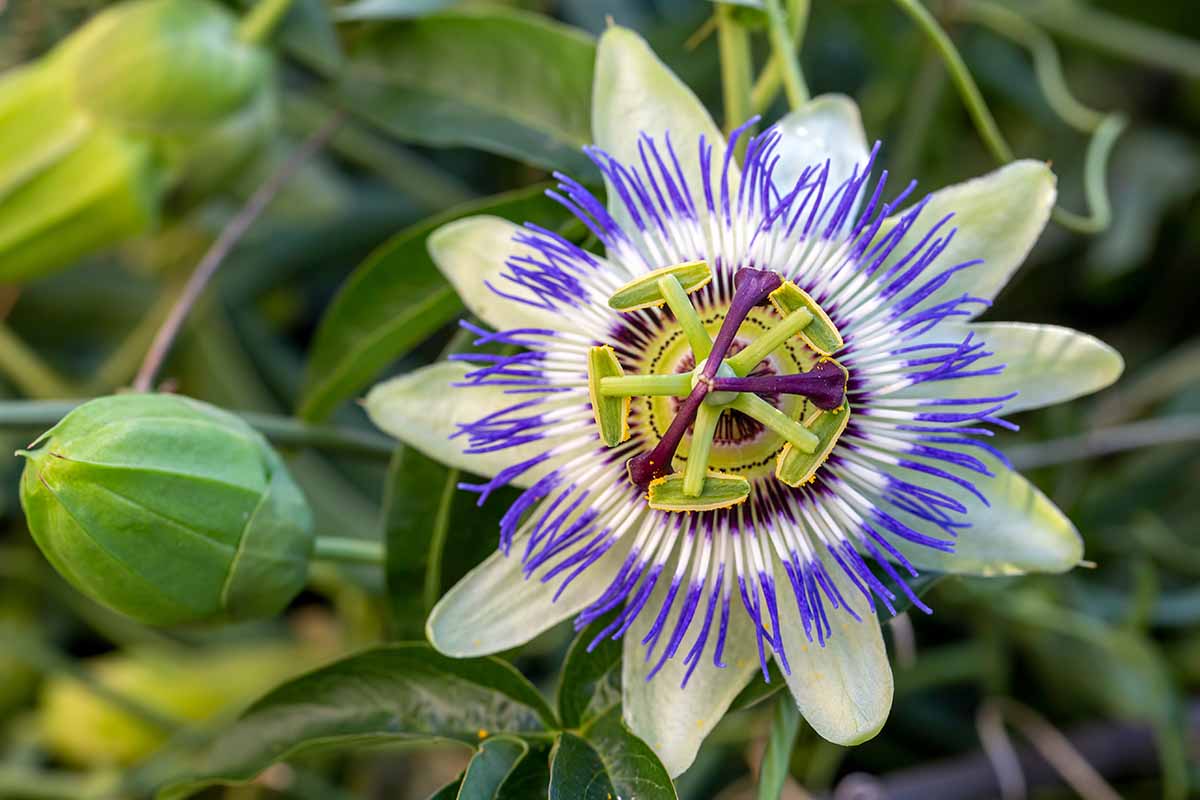
Some of the notable hybrids and cultivars to come out of this species include ‘Constance Eliott,’ ‘Pretty Tina,’ ‘Snow Queen,’ ‘Susanne,’ and ‘Diva.’
You can pick up packets of P. caerulea seeds at Eden Brothers.
2. Blue Bouquet
Hybrid ‘Blue Bouquet’ is exceptionally popular because it features purple, almost blue flowers with white and magenta rings at the center.
It’s a heavy bloomer, and the 30-foot vines will be absolutely smothered in three-inch blossoms during the summer.
One of its parents is P. caerulea, and it retains a similar size and coloring.
It’s not the best option, however, if you’re hoping to eat the fruits. They’re not very flavorful.
3. Cincinnata
P. cincinnata is a Brazil native that has deep purple flowers with just a hint of red. The corollas are longer than the petals and have wavy edges.
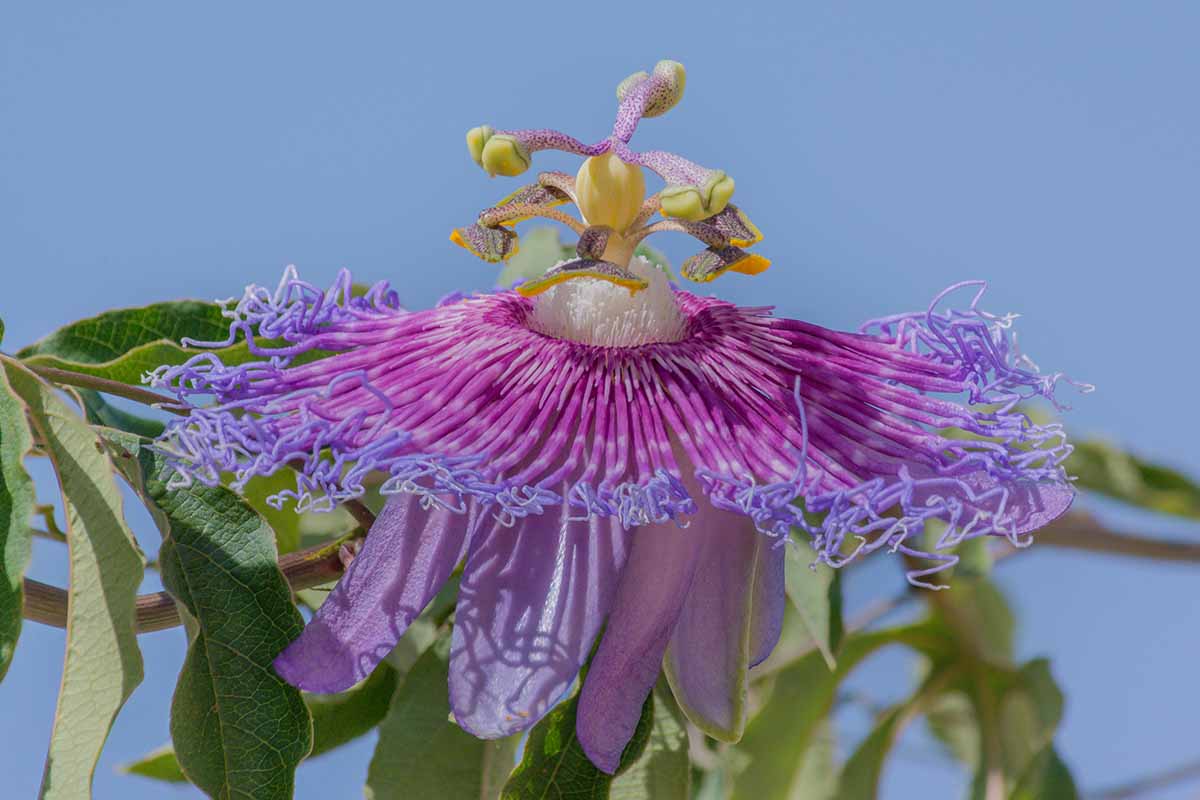
Rarely seen in cultivation, this species has been crossed with others to create several outstanding hybrids, including ‘Frizzle King,’ ‘Incense,’ ‘Liliana,’ and ‘Catherine Howard.’
4. Citrina
P. citrina was described in 1991 by American botanist John M. MacDougal. He found this passionflower species growing wild in Honduras.
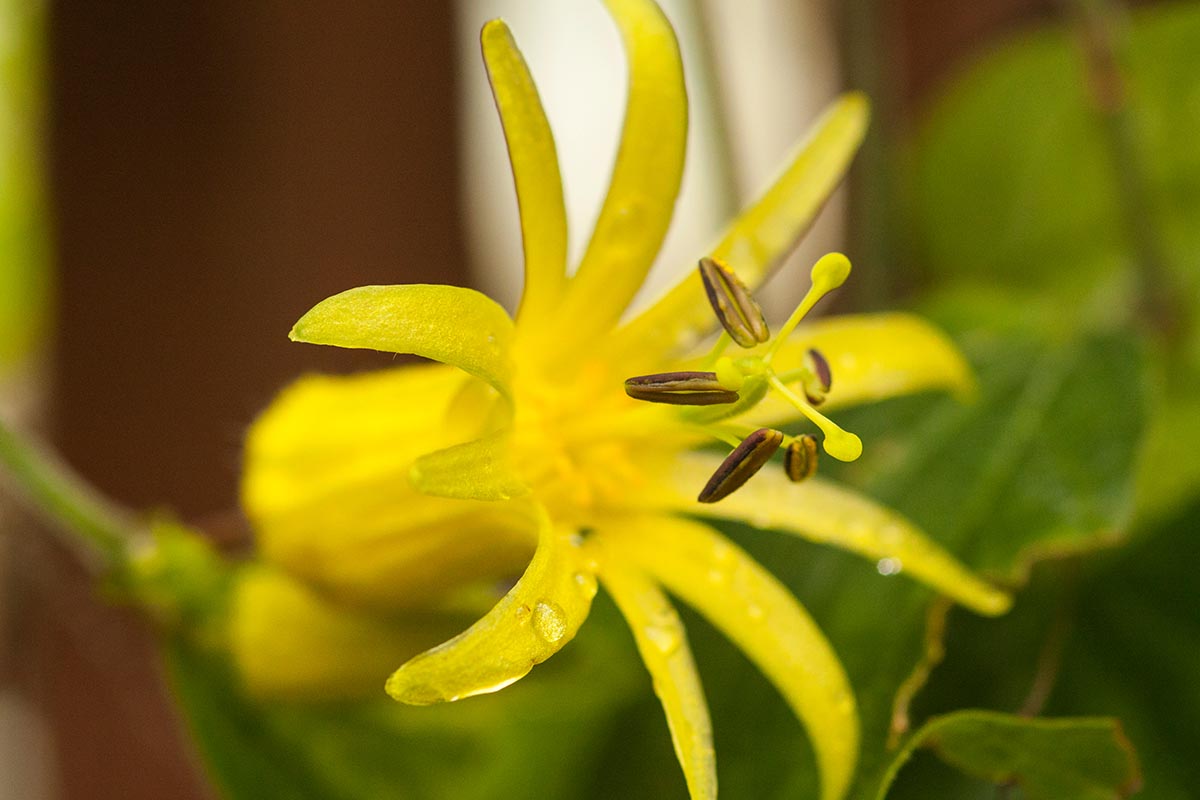
This little guy has petite yellow flowers and is usually grown as a houseplant, as it can flower for up to 10 months of the year.
Hybrid cultivars of this species include ‘Becky Speed,’ ‘Golden Jubilee,’ and ‘Polly Molly.’
5. Damsel’s Delight
Passionflower breeder extraordinaire Myles Irvine created this hybrid, though he hasn’t revealed its parentage.
It was originally called ‘Silly Cow’ as a term of endearment for his dear friend, but he has since renamed it ‘Damsel’s Delight.’
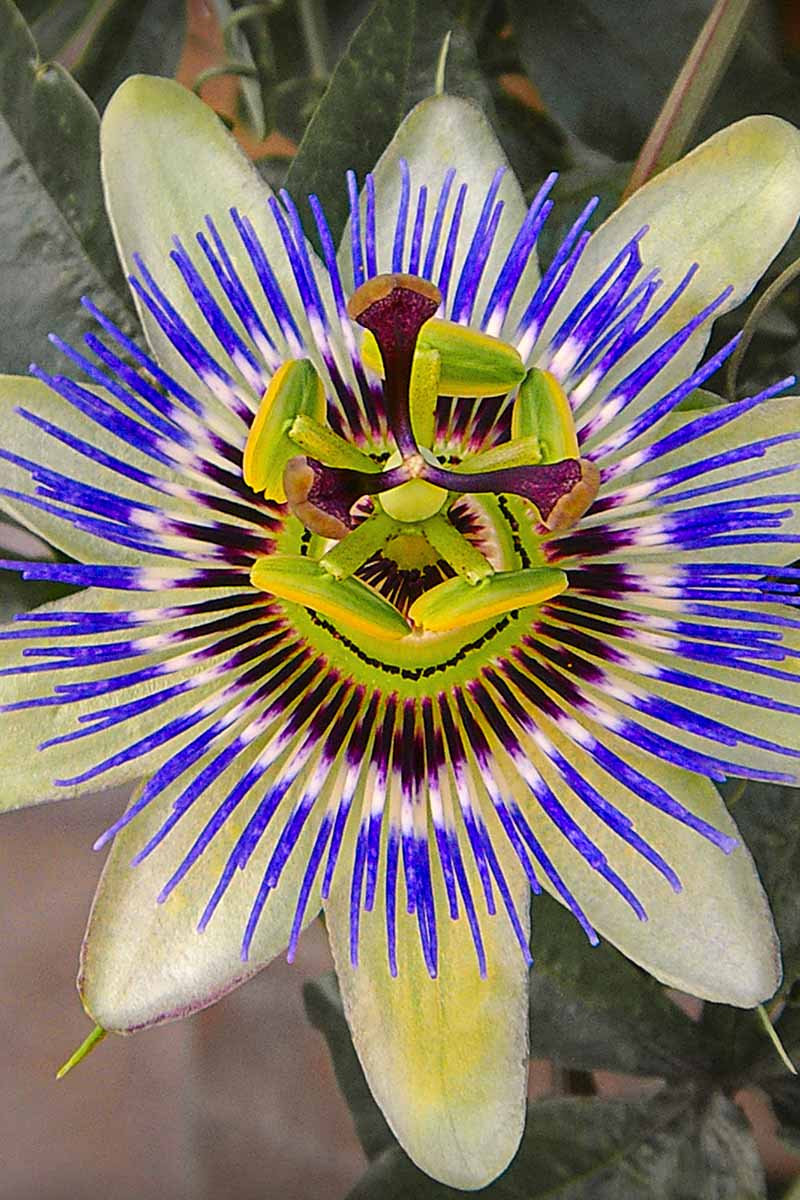
The five-inch-wide flowers have white petals and wavy purple filaments that are tinged with dark purple at the center.
Whatever you call this cultivar, it’s a beauty. Don’t select this hybrid if you’re aiming to grow fruits, though. It’s sterile and doesn’t set fruit.
6. Elizabeth
Beautiful ‘Elizabeth’ was created by breeder Patrick Worley who hybridized P. phoenicea ‘Ruby Glow’ and P. incarnata.
It has flat, purple petals with violet and magenta coronas that twist and curl around each other. It’s a robust plant that is covered profusely in four-inch flowers all summer long.
‘Elizabeth’ also has some of the best-tasting fruits, which are large and sweet.
7. Gritensis
P. gritensis isn’t a common species at nurseries, but hybrids of this Colombian native are some of the prettiest options out there.
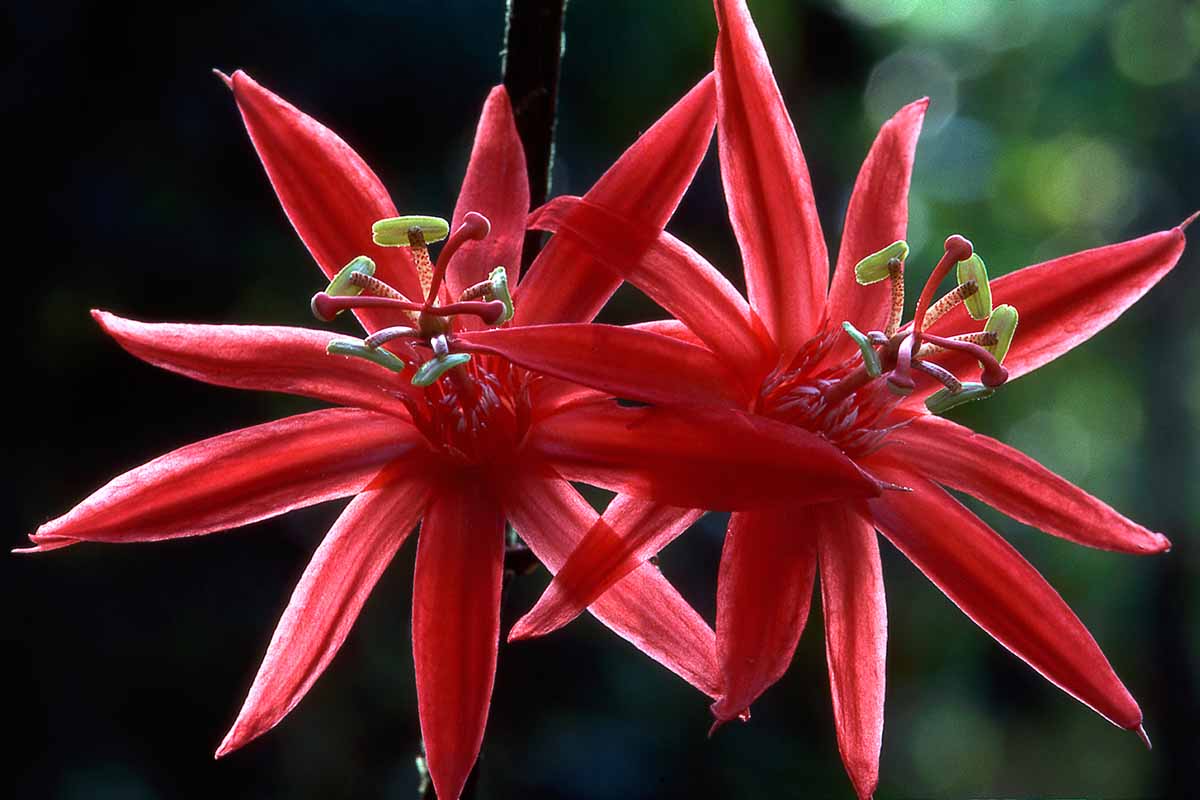
The flowers have huge fuchsia petals with a faint white stripe along the midvein. The petals fold back, putting the salmon-colored corona front and center.
Some of the more notable hybrids include ‘Anastasia,’ with salmon and white filaments, and ‘Grand Duchess,’ with extraordinary pink petals.
8. Incense
P. incarnata and P. cincinnata were crossbred to create ‘Incense,’ a stunning purple hybrid. The corona and petals are deep purple, with long, wavy filaments.
This is one of the hardiest passionflowers, and it can survive temperatures down to 0°F. It also has beautiful dark green leaves and tasty, sweet fruits.
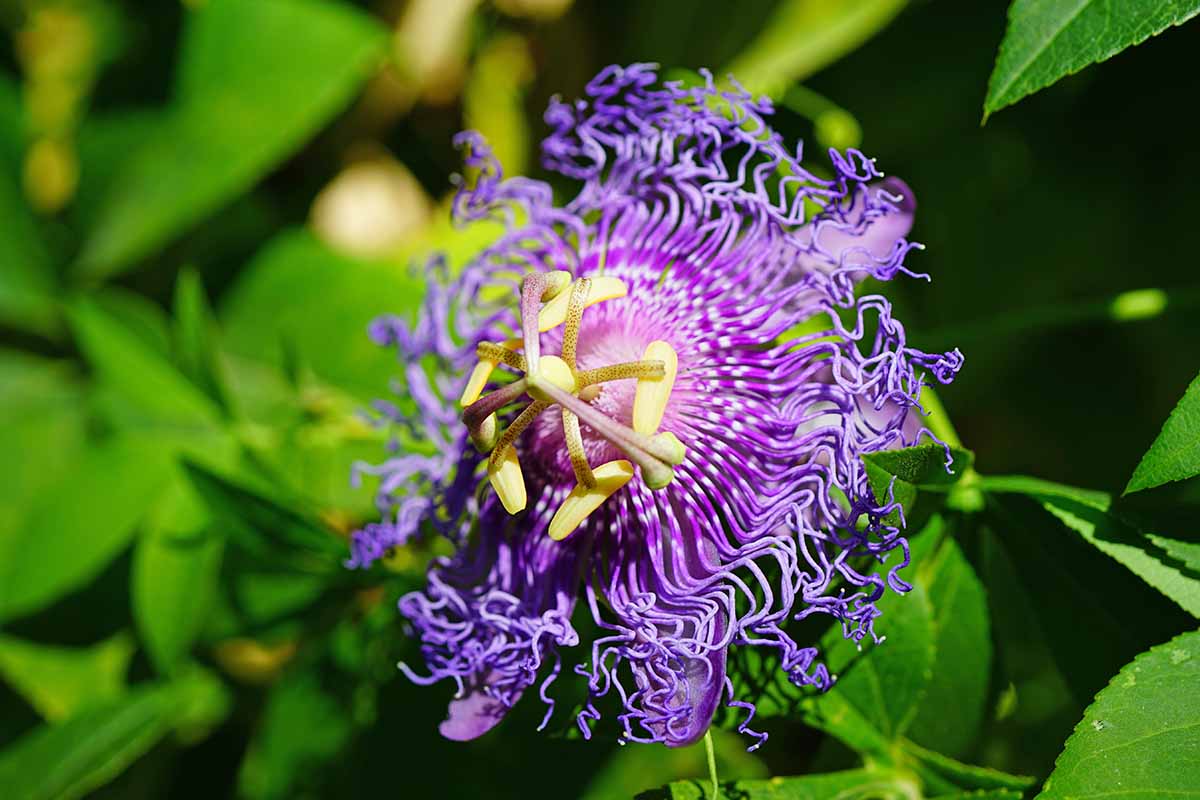
This hybrid can do it all. No wonder it nabbed the Royal Horticultural Society’s Award of Merit in 1976!
If the vine is killed by cold weather, it will regenerate from the roots so long as temperatures don’t drop too much below 0°F. To grow a good crop of fruits, plant it with a purple passionflower to cross-pollinate.
9. Lady Margaret
Lovely ‘Lady Margaret’ is a hybrid of P. coccinea and P. incarnata.
Just like its scarlet parent, she has long, raspberry-red petals. The corona has a bright white center with long, wavy filaments in purple with stripes of magenta and white.

Grab a plant in a four-inch pot from 9GreenBox via Amazon.
10. Passionfruit
Purple granadilla (P. edulis) has a beautiful flower with frilly curled purple and white filaments over snowy white petals, and it would be worth growing this species for the blossoms alone.
But the flower produces a comparatively massive berry, making it one of the best options for growing edible fruit. It’s the only species known simply as “passionfruit.”
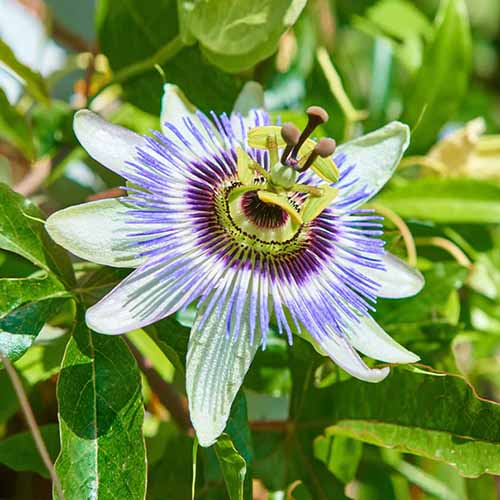
If you want to grow your own edible passionfruit, you can find plants in one- or three-gallon containers available from Fast Growing Trees.
11. Perfumed
Perfumed passionflower (P. vitifolia) is named for its heavily fragrant fruit, but there’s a catch.
When the berry falls off the plant, it’s extremely sour. But left to ripen for several weeks, it becomes sweeter, like a tart strawberry.

The flower itself is vibrant red with long, lanceolate petals, and short red and white filaments that don’t open against the petals but remain upright.
12. Purple
P. incarnata is native to North America and it’s partially responsible for many of the hybrids you’ll find out there.
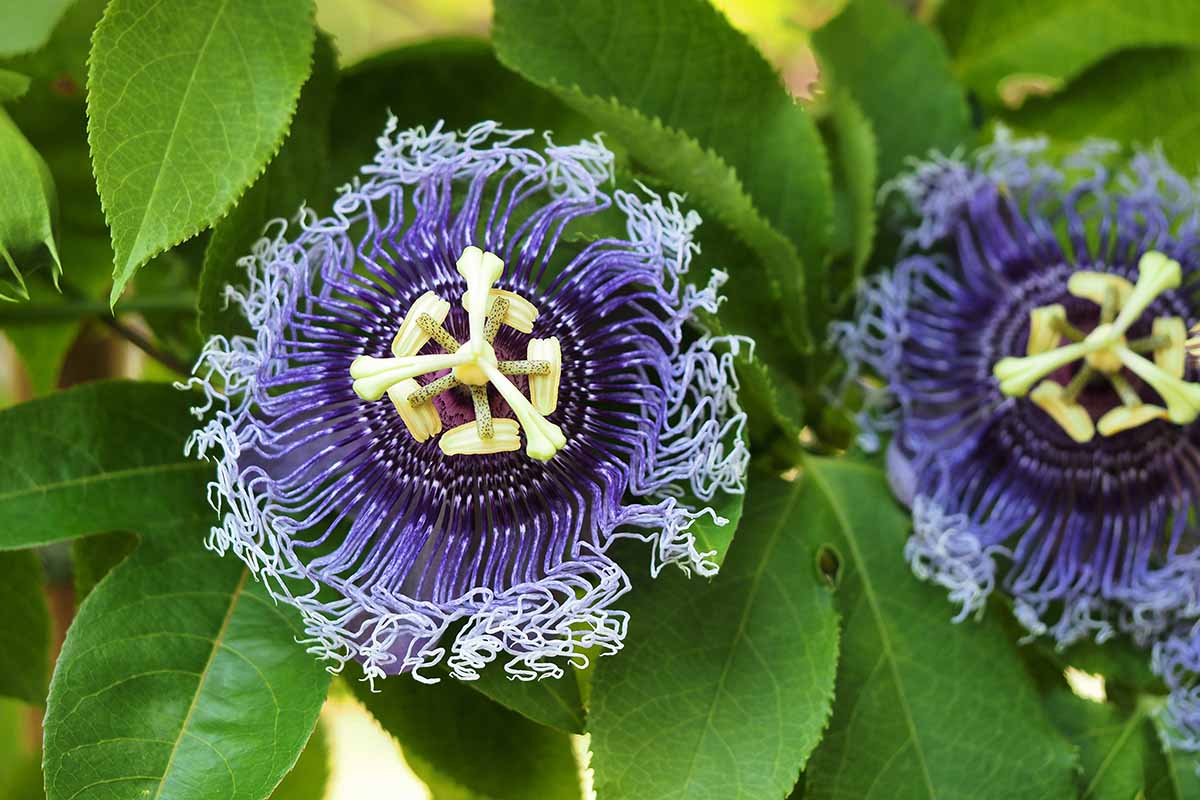
It has pale purple petals and filaments with a small white ring. The filaments are crimped at the ends, giving it a strange, alien-like appearance.
‘Alba’ is a pure-white hybrid that you might like to add to your garden.
Many times, you’ll simply see the plant sold under the species name or under the name “maypops.”
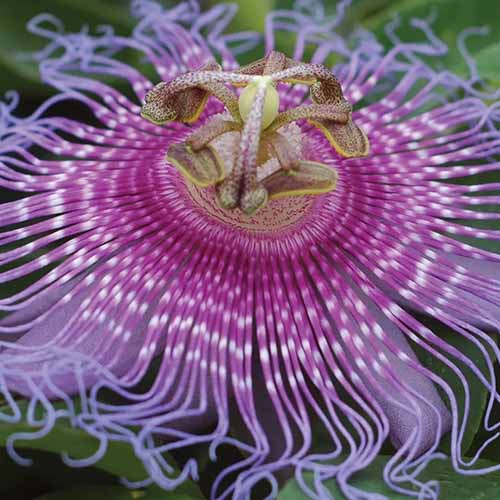
You can find live plants available at Burpee.
13. Red Banana
Also called vanilla passionfruit, P. antioquiensis has some of the largest flowers in the genus, up to six inches across!
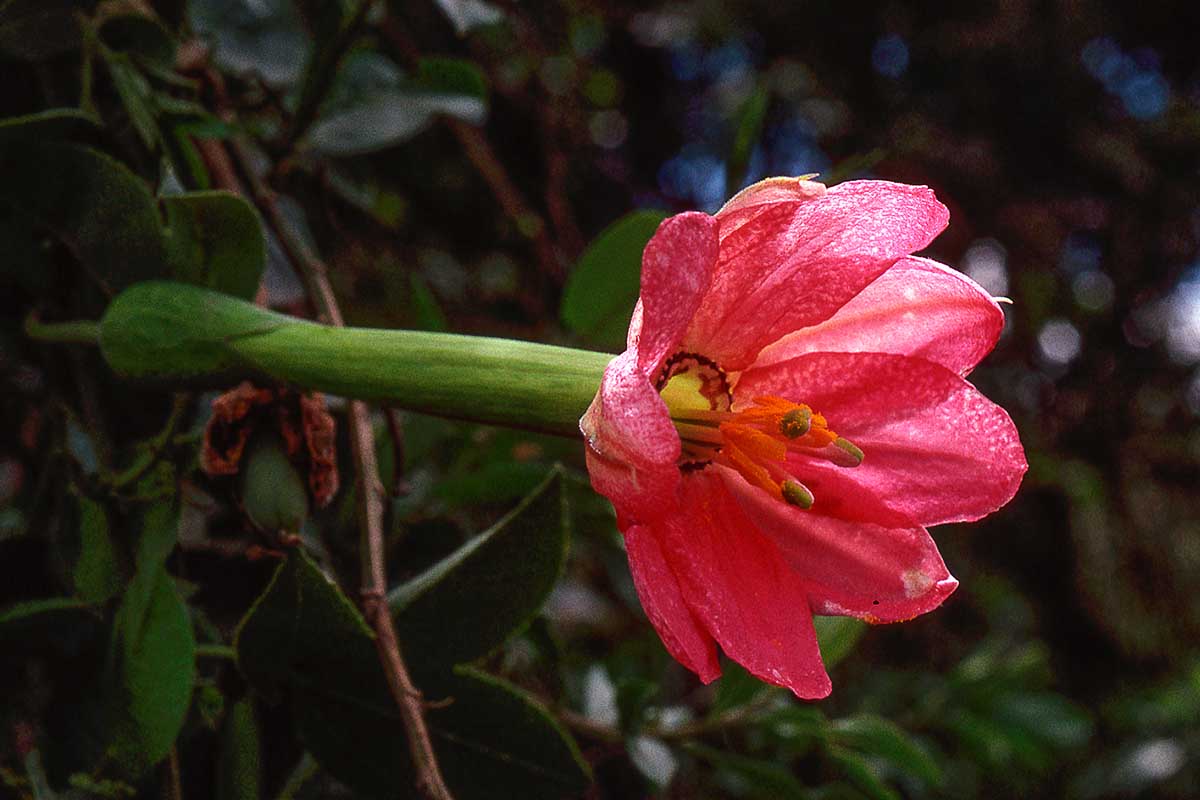
They have bright fuchsia-red petals with petite purple corollas. The fruits are long, green, and almost banana-shaped.
14. Red
The Brazilian native red passionflower, P. racemosa, varies slightly from some of its family in that the petals are the star of the show rather than the filaments.
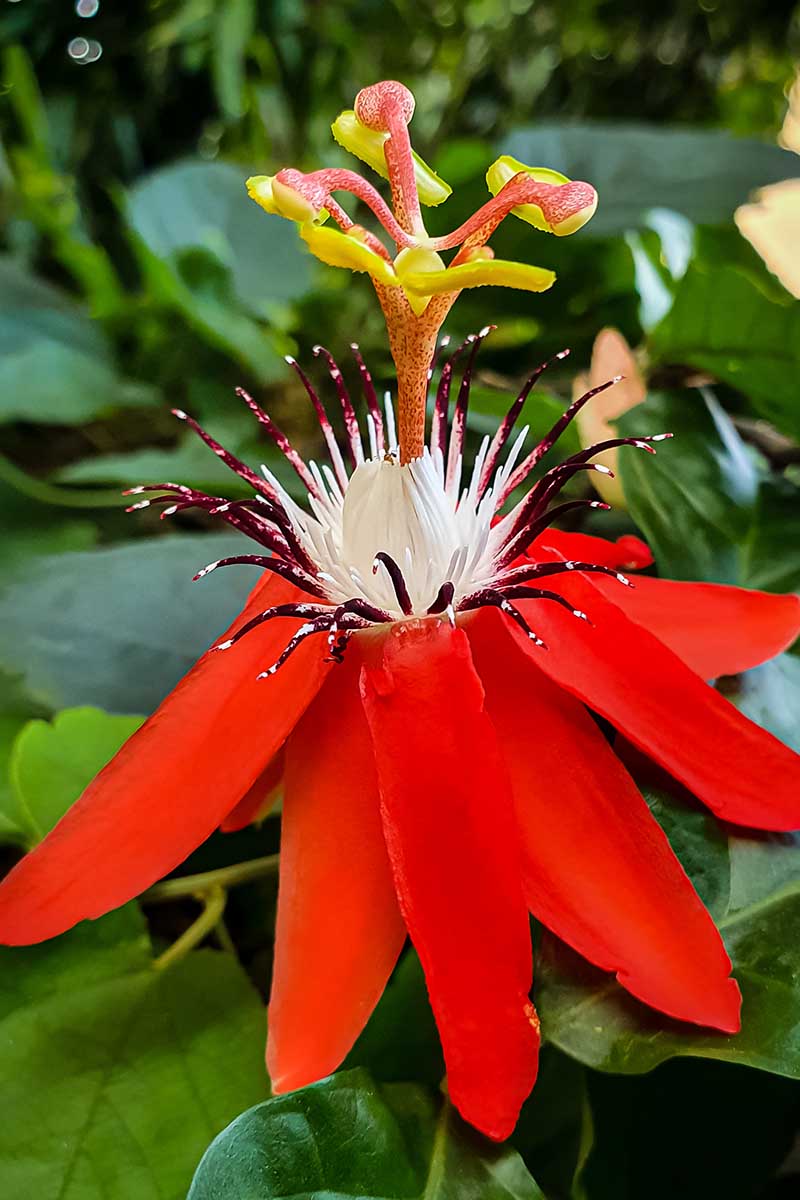
The long, salmon-red petals frame thick, short, cream-colored filaments and a prominent green anther.
Don’t confuse this species with P. manicata, which is also called red passionflower. In addition to sharing a common name, they look similar.
15. Scarlet
Scarlet passionflower (P. coccinea) has long, velvety, vivid red petals and white and blood-red filaments. The flowers can be up to four inches across.
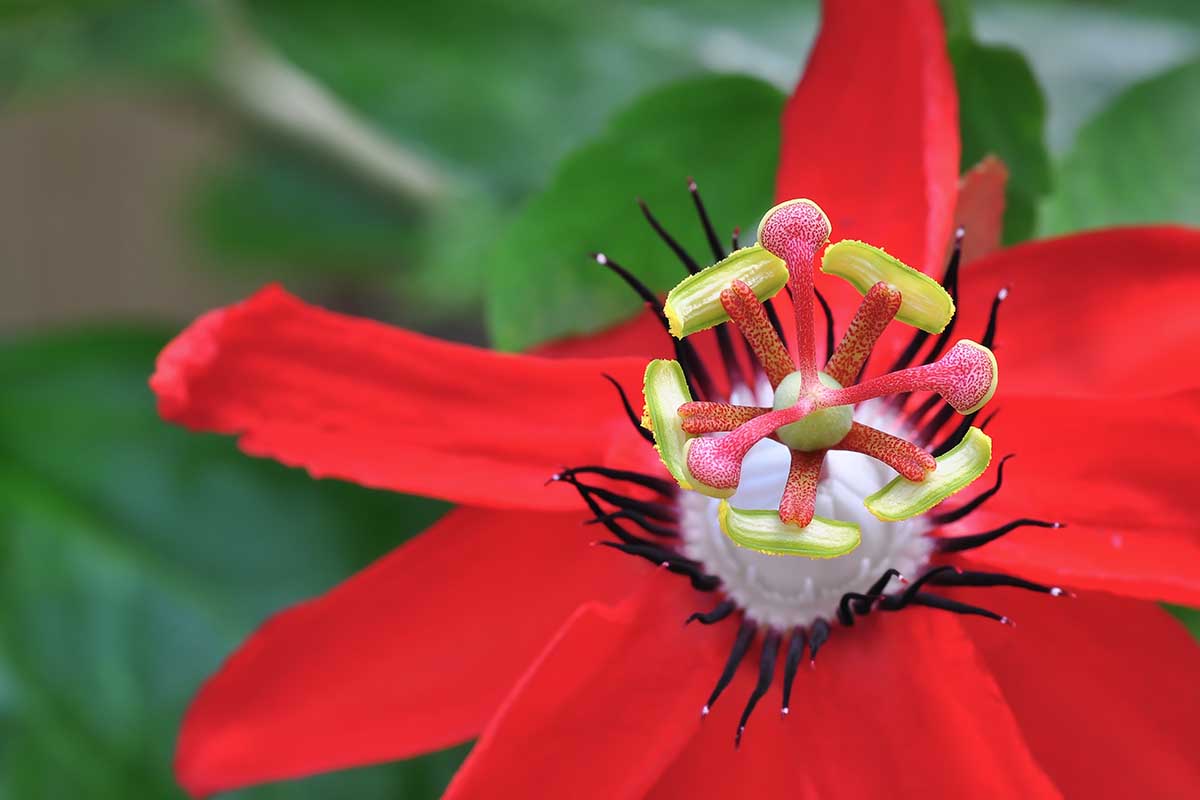
This is one species that doesn’t mind partial sun. You’ll still have a vibrant show of blooms, even without full sun exposure.
Notable hybrids include ‘Cordelia,’ ‘Hot Shot,’ ‘Sherry,’ and ‘Wil.’
16. Stinking
The stinking passionflower (P. foetida) only stinks if you disturb the flowers, so don’t worry about turning your yard into a fetid spot that no one wants to hang out in.
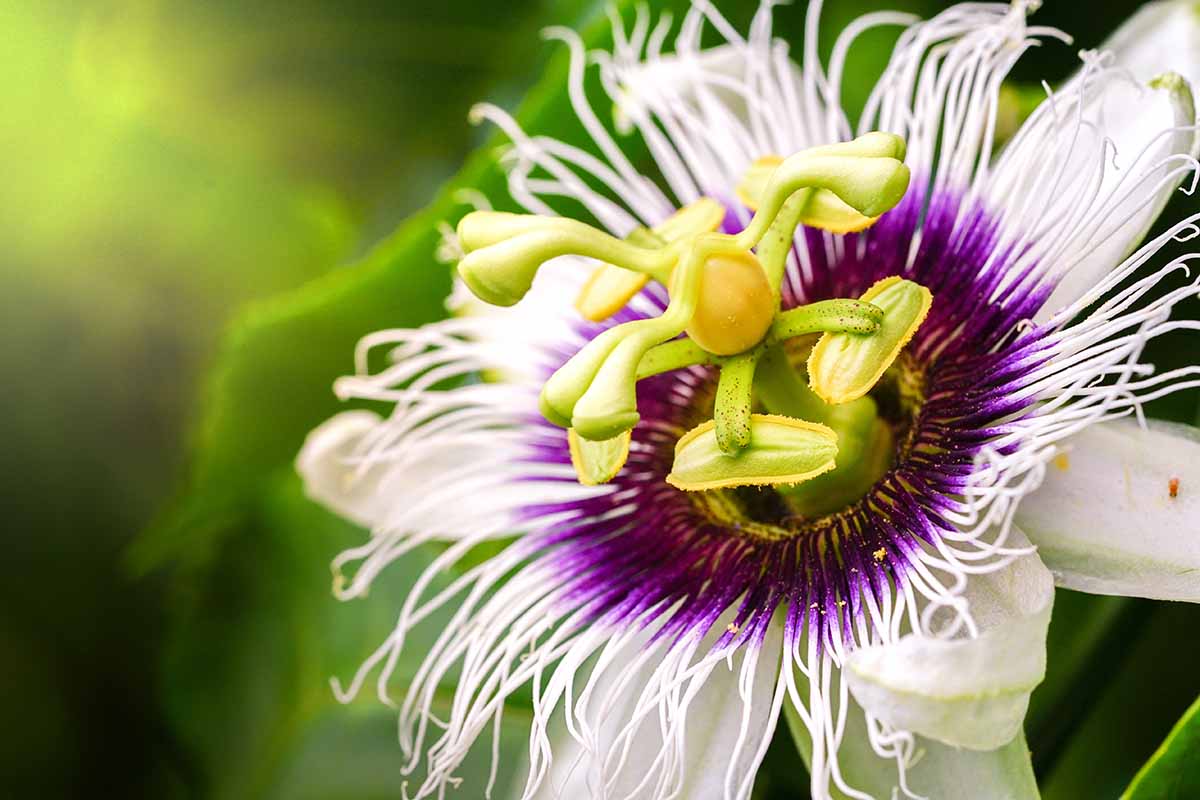
The bad news is that this plant has become invasive in tropical regions across the planet. Still, if you can keep it under control (try container planting!), it’s a worthwhile species to have around.
It has beautifully rounded, white petals and white filaments with a ring of maroon at the center.
‘Alba’ and ‘Aurora’ are two standout hybrids.
17. Winged-Stem
Winged-stem passionflower (P. alata) is distinct from its cousins in that it has bright red petals and purple and white corona filaments, but the filaments don’t open fully. Instead, they stay somewhat closed around the anthers.
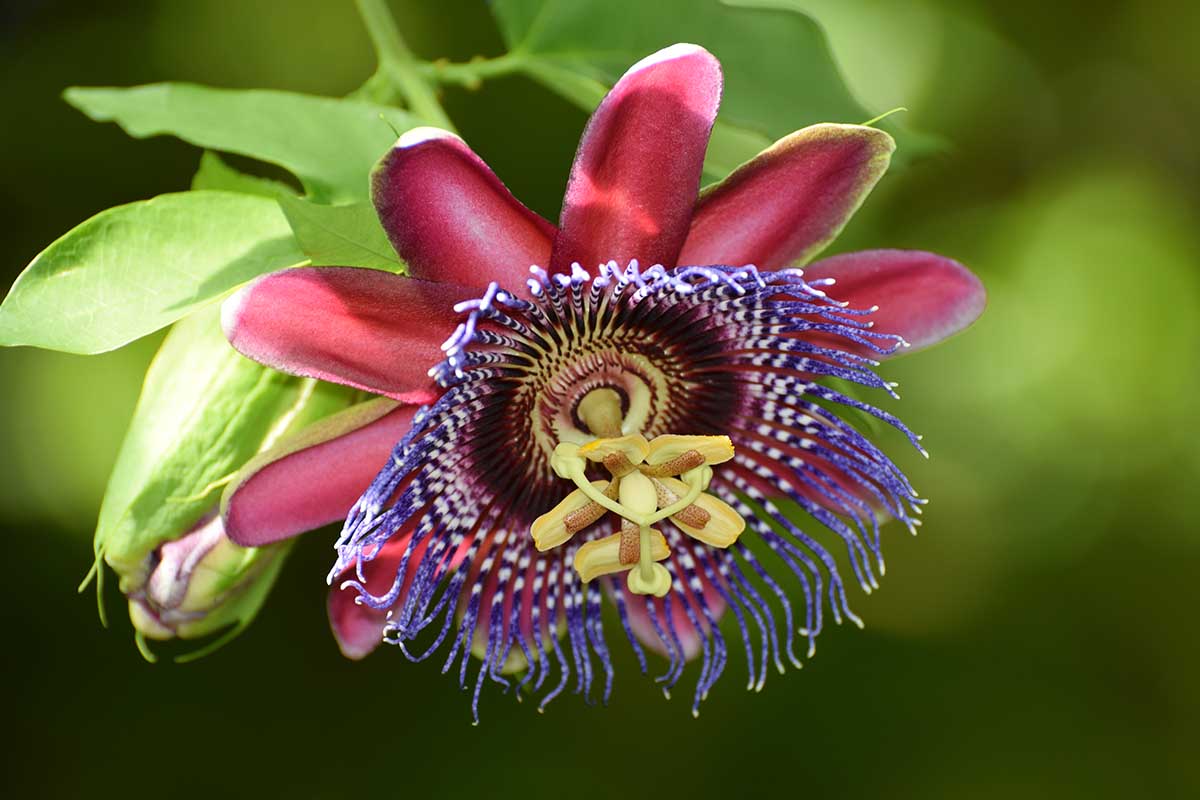
It’s exceptionally fragrant and the fruits are regarded as some of the best tasting of the whole genus.
‘Frederic,’ ‘Nicole,’ ‘Starlight,’ and ‘Superba’ all come out of this species.
A Plethora of Options
When I first saw a red passionflower vine at a nursery, I stood there a bit stumped. Who knew there was something available other than the familiar purple flower? Now, you and I do!
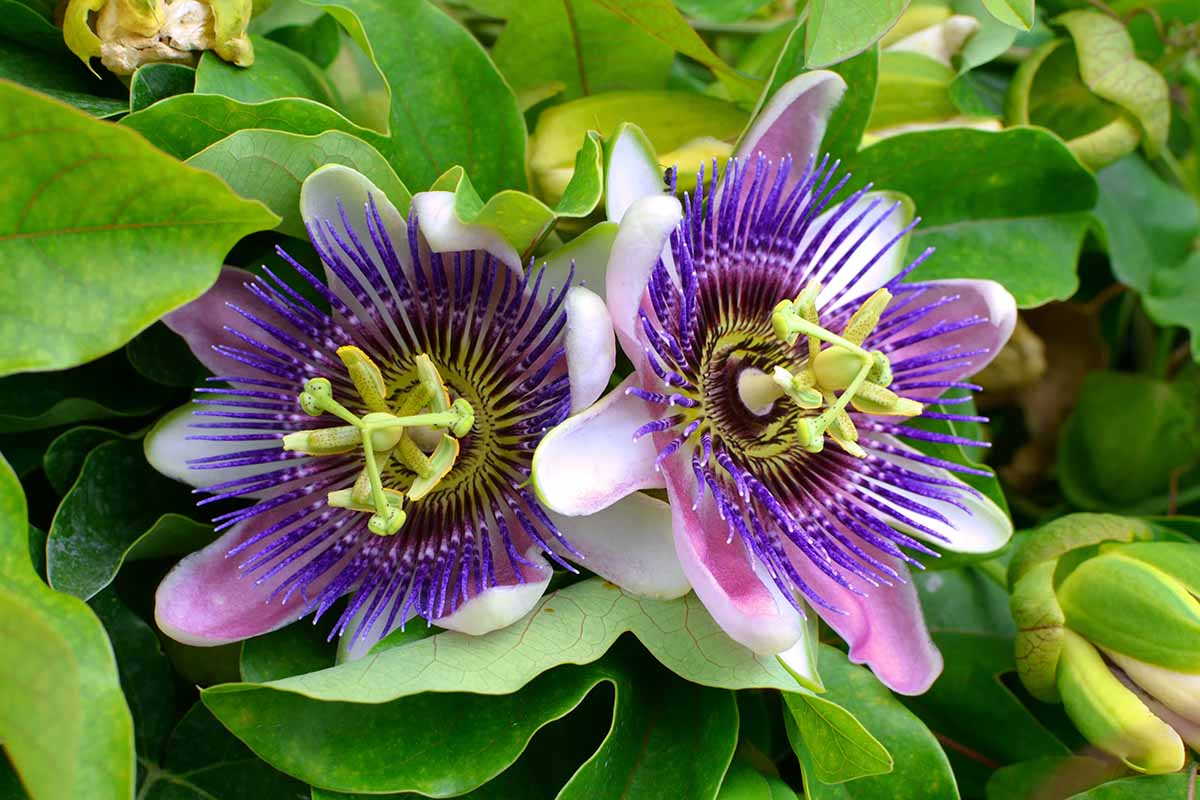
Whether you’re looking for unusual fruits, massive flowers, or a vine that will stick around even when the weather is freezing, one on this list is going to fill the bill. Let us know in the comments below which you end up growing!
If you want to learn more about the beautiful, bold passionflower, check out some of our other guides next, starting with these:

Hi. Fascinating article. Thank you!!!
I’m Lookin for the right water wise pasiflora kind to grow on a pergola in hot Los Angeles , in half day sunny area.
Looking for water wise one, self pollination with sweet passion fruits. Attracts insects is a plus. I have room for 2 plants. Any suggestions.
Hi Esther, I think you’d do well with Passiflora incarnata. This species is drought-tolerant, produces delicious fruits, is self fertile, and attracts lots of good insects. It’s an excellent North American native plant that is reliable and beautiful.
I don’t know If p. manicata is self pollinating, that’s why I have a p. caerulea and a neighbor with a mystery hybrid to collect the flowers from, plus I’m always happy to try new fruit combo’s.
If I was to pollinate the plant I would transfer pollen from one plant to another.
Great article. The first passionfruit I ever tried was from my grandfather’s garden. I remember it had pinkish pulp and not as many seeds as we usually see. I thought I remembered it wrong but my elder sister described it the same way. My gradfather passed away and I never got to know what passion fruit variety it was. Now I keep searching for it and never found anything similar. He was in Australia and I am now in Australia too.
Hey, I’m honestly not exactly sure what species of fruit you and your sister were enjoying. Could it have been Bluecrown passionfruit (Passiflora caerulea)? If this is the one you had, it would have had orange skin rather than the brownish-reddish-purple of the more common types.
I’m currently growing p. manicata, a red variety with green fruits native to Ecuador and Columbia. I live in central to Northern California so I hope it grow well, we don’t get any frost or snow that I know of, at least not in the Bay Area. It’s mostly ornamental but the fruit is edible, I heard that it is hallucinogenic though as its name states(diablito/little devil). I just hope I can enjoy a harvest of delicious juicy sweet or sour fruit to juice.
Hello, thanks for sharing! P. manicata is truly striking, sounds like you’re lucky to live in an area where it should thrive. Fascinating about the potential hallucinogenic properties. Passionflower is a known sedative so I wonder if the same compounds at play in its sedative characteristics factor into any hallucinogenic effect. You’ll have to keep us updated if you do get to enjoy a harvest.
Thank you for this helpful info. I live in northeast Florida and I am passionate about passion flowers. I have several varieties in my yard and wasn’t sure exactly what kind they were, so your article and the photos solved that issue. And now I know one of those will actually produce fruit…can’t wait! My passion vines are marvelous hosts to the zebra longwing and gulf frittilary butterflies in our area. We’ve had a lot of deforestation and it’s nice to give them a place to lay their eggs. I’ll collect the stems with the eggs and raise them until… Read more »
Hello! I’m happy to find your article on passionflowers. I’m on a quest to identify the passion flowers you posted at the end of this article. I grew them on my front fence for 35 years. They were kind of like a signature plant for my garden. (If that makes any sense) People on their walks would see the passion flowers and want to know what I had growing. Fast forward, a fire burned my house and garden a few years ago…I miss my passion flowers. They were the same ones you show at the end of this article. I… Read more »
Hi Marla, I’m so sorry to hear about the fire. That picture is a cultivar of Passiflora incarnata, though I’m not sure which one. It’s the most common one on the market, so if any local nurseries carry passionflowers, they likely have some version of this.